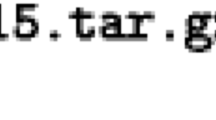Abstract
Two useful statistical methods for generating a latent variable are described and extended to incorporate polytomous data and additional covariates. Item response analysis is not well-known outside its area of application, mainly because the procedures to fit the models are computer intensive and not routinely available within general statistical software packages. The linear score technique is less computer intensive, straightforward to implement and has been proposed as a good approximation to item response analysis. Both methods have been implemented in the standard statistical software package GLIM 4.0, and are compared to determine their effectiveness.
Similar content being viewed by others
Explore related subjects
Discover the latest articles, news and stories from top researchers in related subjects.References
Aitkin M. 1996. A general maximum likelihood analysis of overdispersion in generalized linear models. Statistics and Computing 6: 251-262.
Aitkin M. 1998. Personal communication.
Aitkin M., Anderson D., Francis B., and Hinde J. 1989. Statistical Modelling in GLIM. Oxford University Press, Oxford.
Aitkin M. and Francis B. 1995. Fitting overdispersed generalized linear models by non-parametric maximum likelihood. GLIM Newsletter 25: 37-45.
Albanese M.T. 1990. Latent variable models for binary response. PhD Thesis. University of London.
Albanese M.T. and Knott M. 1990.Twomiss: A Computer Program for Fitting a One-or Two-Factor Logit-Probit Latent Variable Model to Binary Data when Observations may be Missing. London School of Economics and Political Science, London.
Bartholomew D.J. 1983. Latent variable models for ordered categorical data. Journal of Econometrics 22: 229-243.
Bartholomew D.J. 1984. Scaling binary data using a factor model. Journal of the Royal Statistical Society B 46: 120-123.
Bartholomew D.J. and Knott M. 1999. Latent variable models and factor analysis, 2nd edn. Kendall's Library of Statistics 7. Arnold, London.
Birnbaum A. 1968. Some latent trait models and their use in inferring an examinee's ability. In: Lord F.M. and Novick M.R. Statistical Theories of Mental Test Scores with Contributions by A. Birnbaum. Addison-Wesley, Reading, MA.
Bock R.D. and Aitkin M. 1981. Marginal maximum likelihood estimation of item parameters: Application of an EM Algorithm. Psychometrika 46: 443-459.
Carstairs V. and Morris R. 1991. Deprivation and Health in Scotland. Aberdeen University Press.
Dempster A.P., Laird N.M., and Rubin D.B. 1977. Maximum likelihood from incomplete data via the EM algorithm. Journal of the Royal Statistical Society B 39: 1-38.
Dietz E. and Böhning D. 1995. Statistical inference based on a general model of unobserved heterogeneity. In: Seeber G., Francis B., Hatzinger R., and Steckel-Berger G. (Eds.), Lecture Notes in Statistics, Vol. 104. Springer-Verlag, New-York, pp. 75-82.
Goodman L.A. 1979. Simple models for the analysis of association in cross-classifications having ordered categories. JASA 74: 537-552.
Green M. 1989. Generalisations of the Goodman association model for the analysis of multi-dimensional contingency tables. Lecture Notes in Statistics 57: 165-171.
Green M. 1994. Social indices and factor analysis for categorical variables. In: 9th International Workshop on Statistical Modelling. Exeter University, 11–15 July. Centre for Applied Statistics, Lancaster University.
Jöreskog K.G. and Sörbom D. 1996. LISREL 8: User's Reference Guide. Scientific Software International, Hove and London.
Laird N.M. 1978. Nonparametric maximum likelihood estimation of a mixing distribution. Journal of the American Statistical Association 73: 805-811.
Lancaster G. 1998. The use of socioeconomic indices in assessing risk factors for ill-health. PhD Thesis. Lancaster University.
Lauritzen S.L. and Wermuth N. 1989.Graphical models for associations between variables, some of which are qualitative and some quantitative.The Annals of Statistics 17:31-57.
Lawley D.N. 1943. On problems connected with item selection and test construction. Proceedings of the Royal Society of Edinburgh 61: 273-287.
Lindsay B.G. 1983. The geometry of mixture likelihoods: Part I. A general theory. Annals of Statistics 11: 86-94.
Lord F.M. and Novick M.R. 1968.Statistical Theories of Mental Test Scores with Contributions by A. Birnbaum.Addison-Wesley, Reading, MA.
McCullagh P. and Nelder J.A. 1983. Generalized Linear Models. Chapman and Hall, London.
Meng X. and Rubin D. 1991. Using EM to obtain asymptotic variance-covariance matrices: The SEMalgorithm. Journal of the American Statistical Association 86: 899-909.
Muthén B. 1987. LISCOMP: Analysis of Linear Structural Equations with a Comprehensive Measurement Model. Scientific Software, Chicago.
Schwarz H.R. 1989. Numerical Analysis: A Comprehensive Introduction. John Wiley and Sons, New York.
Shea B.L. 1985. POLYFAC User Guide. London School of Economics, London.
Shi J.Q. and Lee S.-Y. 1997. Estimation of factor scores with polytomous data by the EM algorithm. British Journal of Mathematical and Statistical Psychology 50: 215-226.
Whittaker J. 1989. Discussion of paper by P.G.M. van der Heijden, A. de Falguerolles, and J. de Leeuw. 1989. A combined approach to contingency table analysis using correspondence analysis and log-linear analysis. Applied Statistics 38: 249-292.
Wood A. and Hinde J. 1987. Binomial variance component models with a non-parametric assumption concerning random effects. In: Crouchley R. (Ed.), Longitudinal Data Analysis. Avebury, Aldershot, pp. 110-128.
Zhou S. and Maller R.A. 1995. The likelihood ratio test for the presence of immunes in a censored sample. Statistics 27: 181-201.
Rights and permissions
About this article
Cite this article
Lancaster, G., Green, M. Latent variable techniques for categorical data. Statistics and Computing 12, 153–161 (2002). https://doi.org/10.1023/A:1014886619553
Issue Date:
DOI: https://doi.org/10.1023/A:1014886619553




